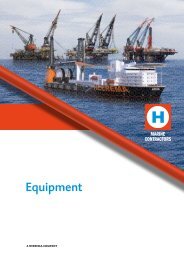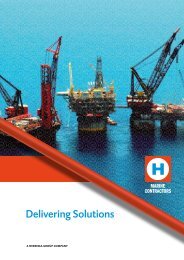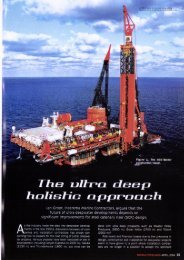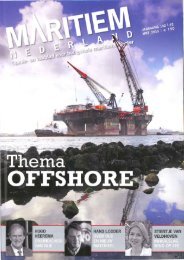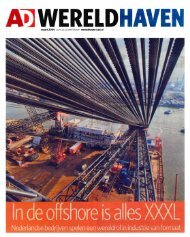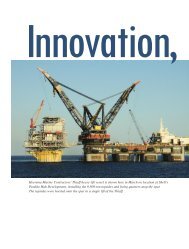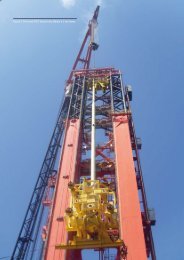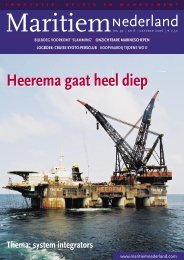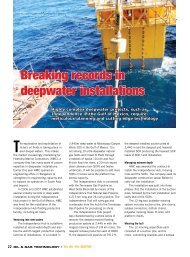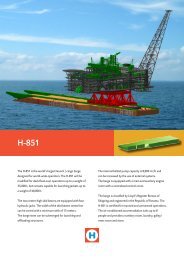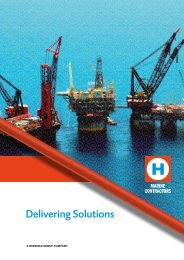Perdido steps out - Heerema Marine Contractors
Perdido steps out - Heerema Marine Contractors
Perdido steps out - Heerema Marine Contractors
You also want an ePaper? Increase the reach of your titles
YUMPU automatically turns print PDFs into web optimized ePapers that Google loves.
APRIL 2009<br />
www.offshore-engineer.com<br />
REQUIRED READING FOR THE GLOBAL OIL & GAS INDUSTRY SINCE 1975<br />
OFFSHORE ENGINEER<br />
Telemedicine eyes<br />
remote offshore<br />
Marathon Brae’s<br />
digital mash-up<br />
<strong>Perdido</strong><br />
<strong>steps</strong> <strong>out</strong><br />
PLUS: WHY THE MARINE SEISMIC BUSINESS IS ‘BETTER PRIMED’ TO MEET THE MARKET CHALLENGE AHEAD
Gulf lease sale<br />
reflects industry<br />
caution<br />
Shell was the top bidder at last<br />
month’s Central Gulf of<br />
Mexico Oil & Gas Lease Sale<br />
208, submitting the highest bid<br />
for a single block and the<br />
largest total amount among<br />
the 70 companies participating<br />
in the sale, the Minerals<br />
Management Service (MMS)<br />
reported. But a subdued oil &<br />
gas market kept the numbers<br />
well below those of the last<br />
Central Gulf leasing round,<br />
2008’s sale 206, which netted<br />
$3.67 billion in high bids<br />
compared with $703 million<br />
this time.<br />
Shell Gulf of Mexico<br />
submitted a high bid of<br />
$65.6 million on Mississippi<br />
Canyon block 721 and was the<br />
high bidder overall,<br />
committing $153.6 million on a<br />
total of 39 tracts. BP bid the<br />
second highest total with $77.5<br />
million for 27 blocks, followed<br />
by Marathon Oil at<br />
$62.4 million for 16 high bids.<br />
Rounding <strong>out</strong> the top five<br />
companies were Noble Energy,<br />
with 24 blocks at $55.4 million,<br />
and BHP Billiton, which<br />
submitted 28 high bids for a<br />
total of $50.4 million.<br />
In all, 348 blocks <strong>out</strong> of the<br />
6458 on offer received bids. A<br />
total of 476 bids were<br />
TOPPING PERDIDO: Shell Oil’s record-setting <strong>Perdido</strong> project<br />
in a remote part of the deepwater Gulf of Mexico’s Alaminos<br />
Canyon passed another key milestone mid-March when<br />
<strong>Heerema</strong>’s Thialf crane barge installed the spar platform’s<br />
9500-ton topsides in around 8000ft of water. Hookup and<br />
commissioning is now under way (see ‘Deepwater Roundup’<br />
feature, page 56 and installation report, page 96).<br />
Russ Ford, Shell’s technology vice president for the<br />
submitted with the sum of all<br />
bids reaching $933,649,315.<br />
High bids are subject to MMS<br />
review and approval.<br />
Statoil Gulf of Mexico bid<br />
digest<br />
$49.3 million on nine leases,<br />
followed by Repsol E&P’s $48.5<br />
million on 20 blocks;<br />
ExxonMobil’s $24.5 million<br />
commitment at 15 tracts;<br />
Americas, said: ‘<strong>Perdido</strong> is a technological tour de force that is<br />
opening up a new frontier for global oil & gas production.<br />
Once the global economy recovers, the energy challenge will<br />
return with a vengeance, and new sources of energy will be<br />
required. Producing oil safely and responsibly this far <strong>out</strong> and<br />
this deep should allay concerns ab<strong>out</strong> industry access to the<br />
85% of the US Outer Continental Shelf that remains<br />
undeveloped.’<br />
$22.4 million in bids by<br />
Chevron for 21 blocks; and<br />
Colombian NOC Ecopetrol,<br />
which was the high bidder on<br />
26 blocks with $20.6 million.<br />
www.offshore-engineer.com OFFSHORE ENGINEER | april 2009 13<br />
PHOTO: JAN BERGHUIS, HEEREMA<br />
DIGEST
DEEPWATER ROUNDUP<br />
56<br />
<strong>Perdido</strong> AC 857, US Gulf of Mexico Shell<br />
The deepest spar installed to date – in<br />
ab<strong>out</strong> 8000ft of water – brings Shell <strong>steps</strong><br />
closer to bringing its <strong>Perdido</strong><br />
development onstream near the<br />
US-Mexico border of the Gulf of Mexico.<br />
<strong>Heerema</strong>’s Balder connected the Shelloperated<br />
<strong>Perdido</strong> Spar to its moorings in<br />
August 2008. <strong>Heerema</strong>’s Thialf mated the<br />
topsides, constructed by Kiewit in Texas,<br />
with the spar, constructed by Technip in<br />
Finland, in a single lift in 1Q 2009 at<br />
Alaminos Canyon block 857 in the US<br />
sector of the Gulf (see page 96).<br />
The <strong>Perdido</strong> spar will serve the Great<br />
White, Silvertip and Tobago fields as the<br />
<strong>Perdido</strong> hub will gather, process and<br />
export production within a 48km radius.<br />
There will be 22 direct vertical access<br />
wells from the spar, with an additional<br />
eight tiebacks from subsea completions.<br />
First oil is expected around the turn of<br />
the decade. Oil will be brought to the<br />
surface by 1500hp electric pumps; gas will<br />
be separated at the sea floor and naturally<br />
rise to the production unit on the surface.<br />
The Noble Clyde Boudreaux has been<br />
drilling the production wells. Tobago, in<br />
ab<strong>out</strong> 9600ft of water, will be the world’s<br />
deepest subsea completion.<br />
The <strong>Perdido</strong> spar, moored with nine<br />
lines, will feature a drilling rig and direct<br />
vertical access wells and full oil and gas<br />
processing and serve remote subsea wells.<br />
Peak production is expected to hit<br />
130,000b/d. New and existing lines will<br />
carry production to shore.<br />
<strong>Perdido</strong> is the deepest oil development,<br />
the deepest drilling and production<br />
platform and serves the deepest subsea<br />
well in the world. The most remote<br />
producing platform in the Gulf of<br />
Mexico, <strong>Perdido</strong> will float 220 miles from<br />
Galveston, Texas; it will provide living<br />
quarters for 150. The helicopter deck will<br />
accommodate two long-range Sikorsky<br />
S92 helicopters simultaneously, each<br />
holding up to 24 passengers and crew.<br />
Williams provided the export system – a<br />
70mile oil line and a 105-mile gas line –<br />
which it completed in December 2008.<br />
Technip got the contract to supply the<br />
steel-tube umbilicals and a 6in flowline<br />
and SCR, and installation was ongoing as<br />
of the writing of this report. Wood Group<br />
provided commissioning services, First<br />
Subsea the mooring connectors, MCS the<br />
contract to qualify the top tensioned<br />
risers, and FMC is providing the trees.<br />
Shell operates the regional host with<br />
35% on behalf of partners Chevron with<br />
37.5%, and BP with 27.5%. Shell operates<br />
Great White – discovered in 2002 – in<br />
Alaminos Canyon blocks 812, 813, 814, 857,<br />
900 and 901 with 33.34% on behalf of<br />
Chevron with 33.33% and BP with 33.33%.<br />
Shell operates Tobago – discovered in 2004<br />
– in Alaminos Canyon block 859 with<br />
32.5%, for partners Chevron with 57.5%<br />
and Nexen with 10%. Shell operates<br />
Silvertip – discovered in 2004 – in<br />
Alaminos Canyon block 815 with 40%<br />
interest on behalf of Chevron with 60%.<br />
OFFSHORE ENGINEER | april 2009 www.offshore-engineer.com
NETHERLANDS OFFSHORE<br />
96<br />
<strong>Perdido</strong> puts another notch<br />
in the HMC deepwater belt<br />
<strong>Heerema</strong> <strong>Marine</strong> <strong>Contractors</strong>’ giant semisubmersible crane barges have done more than their share of<br />
offshore record-breaking over the past 30 years. In the Gulf of Mexico last month, Thialf continued the<br />
good work done by sister vessel Balder in Shell’s <strong>Perdido</strong> field last year by completing installation of the<br />
9500t topsides and living quarters on the spar hull in almost 2500m of water. David Morgan reports.<br />
T<br />
he <strong>Perdido</strong> project, which Shell<br />
operates on behalf of partners BP<br />
and Chevron (see ‘Deepwater<br />
Roundup’ page 56), set several records<br />
including installation of the deepest spar<br />
mooring system and the deepest PLET<br />
(pipe line end termination) yet, at 2950m.<br />
After kicking off the engineering phase<br />
for <strong>Perdido</strong> in June 2006, HMC reckons it<br />
invested around 100,000 man hours in<br />
preparatory work for the project before<br />
offshore installation actually began two<br />
years later.<br />
On 24 October 2008, the company’s<br />
Balder vessel completed the spar and<br />
OFFSHORE ENGINEER | april 2009 www.offshore-engineer.com
subsea installation, consisting of nine<br />
suction piles and polyester mooring lines<br />
– averaging more than two miles in length<br />
to hold the 50,000t floating structure in<br />
place – five flowlines, one water injection<br />
line and three steel catenary risers.<br />
Technip supplied <strong>Perdido</strong>’s umbilicals as<br />
well as the spar’s hull and mooring<br />
system, in the process setting two new<br />
industry records of its own: deepest<br />
reeled flowline installation (in 2961m of<br />
water) and deepest reeled SCR<br />
installation (2469m).<br />
The water depth at <strong>Perdido</strong> required<br />
upgrading of some of Balder’s equipment<br />
for the spar and subsea installation phase,<br />
reports HMC’s <strong>Perdido</strong> project manager<br />
BARGE BRIEFS: The latest addition to<br />
<strong>Heerema</strong> <strong>Marine</strong> <strong>Contractors</strong>’ fleet, the<br />
122m long, 36.6m wide H-405 barge (left),<br />
arrived in Rotterdam mid-March<br />
following a 113-day journey from China<br />
where it was built. The barge was loaded<br />
with 10,300t of ship hulls in four tiers.<br />
The H-405 joins an HMC fleet of three<br />
semisubmersible crane vessels (Thialf,<br />
Balder and Hermod), two anchor<br />
handling tugs (Retriever and Husky),<br />
René de Koeijer. The A&R wire was<br />
replaced by a 4000m long one of 5.5in<br />
diameter, the L&P wire with one of 4000m<br />
and 4.5in diameter, the crane wires with<br />
two of 19,000m and the frame and winch<br />
capacity of the vessel’s ROVs was<br />
increased.<br />
‘Installing in 3000m deep water<br />
involved the use of very sensitive<br />
positioning equipment to ensure<br />
installation within 3m of planned<br />
location,’ says de Koeijer.<br />
‘Not only the equipment was upgraded<br />
but also the working procedures were<br />
refined using the experience gained over<br />
the last five years. This also applied to the<br />
change-over from pipelay mode to<br />
handling mode and vice versa. While a<br />
change-over used to take at least five days,<br />
it was now cut down to one day. This was<br />
mainly due to integrated planning, which<br />
enabled us to carry <strong>out</strong> several tasks<br />
simultaneously, saving us time in the<br />
process.’<br />
<strong>Perdido</strong>’s remote location – around 150<br />
miles from Corpus Christi and 180 miles<br />
from Galveston, with the nearest<br />
platform 80 miles away – was an extra<br />
challenge for the project, recalls HMC<br />
project director Eric Romijn.<br />
‘Installing during the hurricane season<br />
meant we had to have solid hurricane<br />
evacuation plans in place,’ he explains.<br />
‘These detailed what had to be done and<br />
in which order, taking into account the<br />
predicted hurricane r<strong>out</strong>e. The spar is<br />
only storm safe when three mooring lines<br />
are attached to it, so we had to come up<br />
with a way to reduce the installation time<br />
and uncouple/detach the lines if<br />
necessary. Decisions had to be made on<br />
whether it was quicker to complete the<br />
installation of the first three mooring<br />
lines or to reverse the installation. To<br />
shorten the installation time we had<br />
already pre-installed the first three<br />
mooring lines and attached them to a<br />
buoy.<br />
‘We experienced three hurricanes,<br />
which required that Balder leave the<br />
<strong>Perdido</strong> site, move <strong>out</strong> of the direct path<br />
of the hurricane and return five or six<br />
days later to continue installation,’ notes<br />
Romijn.<br />
‘The hurricanes also affected the<br />
schedules of the barges we used, and<br />
and eight barges, including the world’s<br />
largest, the H-851, at 260m in length.<br />
HMC expects shortly to complete the<br />
basic design of its proposed newbuild<br />
crane vessel but has put plans to build<br />
it on the back burner until market<br />
conditions improve. ‘The current oil<br />
price and economic situation are not<br />
favourable for making major<br />
investment and financing decisions,’<br />
said the company.<br />
severely affected our Fourchon and<br />
Houston facilities. This impacted<br />
schedules of both project materials and<br />
personnel. It took some real<br />
determination and dedication to supply<br />
Balder and the tugs to progress with the<br />
work as planned. But all crews, engineers<br />
and contractors did an <strong>out</strong>standing job<br />
and delivered safely and on time.’<br />
The icing on the cake came on 16 March<br />
when Thialf – one of only two vessels in<br />
the world capable of lifting the 9500t<br />
topsides – completed installation of the<br />
drilling and production platform atop the<br />
555ft spar.<br />
Offshore hookup and commissioning<br />
work is now under way. OE<br />
The <strong>Perdido</strong> spar sits in 2500m of water.<br />
LEFT: Thialf applying the finishing<br />
touches to the installation of <strong>Perdido</strong>’s<br />
topsides and living quarters last month.<br />
PHOTO COURTESY SHELL/© JAN BERGHUIS<br />
TERSCHELLING, CAPTAIN OF HEEREMA’S<br />
RETRIEVER<br />
www.offshore-engineer.com OFFSHORE ENGINEER | april 2009<br />
97<br />
NETHERLANDS OFFSHORE




